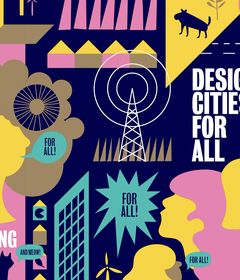How can designers or architects give a voice to the needs and ideas of inhabitants of a city? And which initiatives call for innovative, bold, and inclusive urban development? Together with architect Afaina de Jong, known for her work for among others Venice Architecture Biennale, Rijksmuseum Amsterdam, and Centraal Museum Utrecht, local designers and leading international collectives that shake up the way we work are invited to share their insights. Afaina is currently commissioned by NDSM-werf to create an architectural installation on NDSM, located on the former Sexyland plot, that emphasises the diversity of Amsterdam, NDSM, and its users.
Who do we build for? This question is central to the work of architect Afaina de Jong that varies from exhibition design to pavilions. By creating scenographic and sensory environments that break with the dominant architectural narrative, she opens the debate on representation in architecture and public space. Are our buildings and cities really built with and for everyone who uses them? And which communities feel connected to them and why?
As one of the founders of Blackspace Collective, Amina Hassen focuses on empowering Black planners, architects, artists, and designers as Black urbanists, people who are passionate about the work of public systems and urban infrastructures. Blackspace subverts scarcity-fueled design and urban planning interventions that perpetuate harm in Black communities and stifle Black urbanists. Instead, they promote the articulation and funding of existing assets of Black neighborhoods and the liberation and leadership of urbanists by co-creating, facilitating, and connecting.
Improving racial diversity in the architecture industry might require uncomfortable conversations. Sound Advice founders Joseph Henry and Pooja Agrawal are not afraid to facilitate them. As an architecture diversity platform, Sound Advice creates short quotes and tips on social media, especially on their Instagram page, that they couple with music. Designed to be an alternative to the academic way in which inequality is usually discussed, they hope their platform creates a space for interaction and exploration of inequality in the built environment.
As one of the founders of Studio L A, Arna Mačkić views the practice of architecture as a device through which to investigate societal issues, phenomena, and narratives, and to place them in renewed perspectives. Their projects often relate to inclusion and exclusion mechanisms, refugees, collective identity, and public domain. Their spatial designs do not aspire to be off-the-shelf structures but are allowed to cause friction, often working with local communities.
This program is made possible by the International Visitors Programme of Het Nieuwe Instituut.

Dezeen - Architecture diversity platform Sound Advice creates short quotes and tips on social media that they couple with music, which are designed to be an alternative to the academic way in which inequality is usually discussed. >>

Architectenweb - Die vraag staat centraal in het werk van architect Afaina de Jong. Door het ontwerp van scenografische en zintuiglijke omgevingen, die breken met het dominante architectonische narratief, opent ze het debat over de representatie in de architectuur. >>










